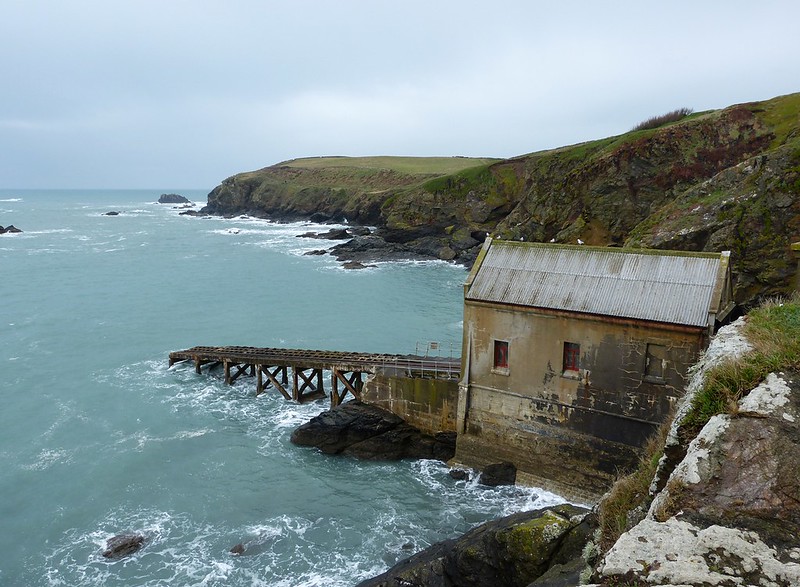The morning after the day before dawned wet, windy and frankly rather Welsh. What had been a view down to the beach at Praa Sands was now obscured by fog and low cloud with even the car attacking Herring Gulls seemingly having sought shelter leaving my windscreen wipers wounded but thankfully still operational. Fortunately conditions started to improve around midday so we headed into Penzance for some ‘urban’ birding/pasty purchasing. Parking up near Jubilee Pool gave us superb views of at least seven Purple Sandpipers feeding on the only area of sand left exposed by the high tide, probably the best views of this species I’ve had away from Aberystwyth. If the sea hadn’t been so rough I may have chanced my luck with the camera but even I could see that wet feet would probably have been the only outcome. Just around the corner and it was Turnstones who proved to be equally showy with several large groups roosting at various points around the harbour. One gathering was perched atop the harbour wall itself whilst another seemed to prefer the company of cars. My favourite though were these birds who’d decided that a life on the ocean waves was clearly preferable to their landlubber cousins.

A single Mediterranean Gull approaching full summer plumage was another nice find though the long staying Surf Scoter proved elusive amongst rolling waves. I did spot a likely candidate off Long Rock but with visibility poor and so many Shags also fishing in the area I didn’t like to commit myself further. Moving along the coast to Mousehole we picked up our first Oystercatchers of the trip in what was another perfectly formed Cornish fishing village.

On Tuesday (25th) conditions again looked a bit dodgy for any significant walking so instead we headed over to Geevor Tin Mine, part of the Cornwall mining world heritage site. Worked up until 1990 it provided a fascinating insight into the modern face of mining across this area with the added bonus of an underground tour into workings dating from at least one hundred years previous. Both the guided tour and static exhibits took up much of the day and I highly recommend a visit if you’re in the area.

Geevor Mine

Levant Mine
As you can see from the photo above, Geevor sits in an enviable position overlooking the sea. The reason for this is clear when you discover that many of the underground tunnels from this and the neighbouring Levant mine stretch out for over a mile under the sea floor. Today these old working are all flooded, by water draining from the land not the ingress of sea water surprisingly, but would surely make for an outstanding attraction if access could once again be established. Above ground we were astonished to see the second Glaucous Gull of our trip floating past, closely followed by two further white-winged gulls that I sadly didn’t manage to identify. Initial impressions were of smaller birds so perhaps they could have been Icelandics? Whatever their identify it just goes to show that you should expect the unexpected, something I always pay attention to exemplified by the fact that my binoculars were nowhere about my person!

Levant Mine
Wednesday finally brought a break in the weather and with it an opportunity to explore the Lizard, mainland Britain’s most southerly point. Last time I visited here I was just a child but its dramatic scenery and lighthouse has remained etched in my memory ever since. I’m pleased to say that time has done it no injustice as we set off on a circular route west to Bass Point and back east to Kynance Cove.

Lizard Point

As you’d probably expect this area offers a wealth of wildlife with Fulmars being the most immediately obvious. We saw at least twenty birds soaring on their characteristically rigid wings along with a couple of pairs perched on what I presume are going to become nesting sites. One bird in particular was right next to the path allowing some superb views of that impressive beak.


A little while later our first Gannets of the year were spotted way out to sea before a trio of recently arrived Wheatears popped up along the cliff edge. Normally my first sighting of these spring migrants is at Rhossili but just this once I’ll let tradition slide. Of course another tradition also states that I should provide a photograph of each years first Wheater so here is 2014’s slightly distant effort.

Perhaps more surprising was that while taking this photo I happened to look down to my left and see two Choughs feeding happily. Aware of their sensitive nature I immediately froze but it seemed that I was of no concern as they went about their business. Raising my camera slowly I managed a couple of shots before both birds wandered back out of sight allowing me a safe retreat. It’s these unexpected encounters that make nature so enjoyable as you just never know what’s around the next corner.

After that anything else was going to have to work doubly hard to impress but another male Wheatear at Caerthillian Cove and a noisy Rookery at The Balk tried their best. A stunning location and one I’ll be sure to return to next time Cornwall calls.



1 Comment
JRandSue · April 7, 2014 at 12:16 pm
Superb post,glad you enjoyed your stay.
John.